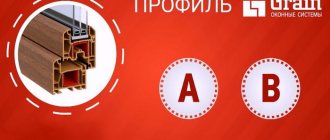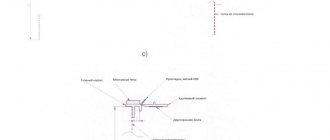Self-adhesive adjacent window profile is one of the new products of recent years in the construction segment. Its task is to form a practical and beautiful slope when installing a plastic window. More specifically, this small structure performs a sealing, protective and plastering function, and also greatly simplifies the tedious process of arranging a window slope. Moreover, not only professional craftsmen, but also people far from construction can use the adjacent profile. To do this, just follow the instructions presented in our review.
Preparation for finishing slopes
The window slopes are essentially the top and side walls of the opening.
Since, when installing a window, we divide the opening into two parts - external and internal, the slopes can be divided into two types, respectively: external and internal. The quarters of the opening act as external ones. Finishing of external slopes is most often limited to the installation of decorative corners and cosmetic repairs to the surface of the quarters (puttying, painting). Internal slopes require more serious treatment, since they are part of the interior of our home and should look, let’s say, decently, harmoniously combined with the impeccable appearance of a modern plastic window.
External slopes
The technology for installing external and internal slopes is basically the same, so only the finishing of internal slopes will be described below. Regarding external slopes, it should be said that there is no need for preliminary insulation of the walls of the opening (quarters), as is done when installing internal slopes. This simplifies the process somewhat. However, installation of external slopes is less convenient than internal ones, and on the upper floors, as you understand, it is also dangerous because you have to work halfway out of the window. When finishing the quarters with plastic panels, it may be difficult to adjust the lower edge of the side panels to the ebb, which is at an angle. But, if we turn to the topic of installing side corners, then there should be no problems here. And finally, the last thing regarding external slopes: if you plan to install them, you need to make the ebb ears large enough in advance :
to the width of the panel of future slopes, otherwise it (the panel) will unattractively protrude beyond the edges of the ebb.
Internal slopes
So, internal slopes. Based on the materials used, they can be divided into three most common types: plaster
,
plasterboard
and
plastic
.
Plaster ones are far from modern, but the cheapest. Perhaps price is their only advantage. Everything else can be attributed to disadvantages:
- long duration of finishing (several days), accompanied by a large amount of debris and dust;
- the need to then regularly tint the surface of the slopes;
- the plaster constantly cracks where it meets the plastic;
- the slope turns out to be cold and susceptible to freezing and mold.
Plasterboard slopes are in perfect harmony with a plastic window, but are easily soiled and require regular painting. If the walls of the opening are not insulated enough, the drywall may become damp in the cold and become moldy. When installed correctly, such slopes are a good option for office and ordinary residential premises.
Plastic slopes are perhaps the most affordable and fastest way to interior finish plastic windows. Given the simplicity of the technology, quite a decent result is achieved with little cost and time. Plastic slopes are ideally combined with a PVC window, as if merging with it into a single whole. In addition, they are practical and durable. If necessary, over time they can be easily and relatively “painlessly” replaced with new ones.
Preparatory work
Before you begin installing plasterboard or plastic slopes, you need to prepare the window and opening. Preparatory work includes installing a starting profile and insulating the walls of the opening.
Start profile
To pair the plastic panels with the window, a special U-shaped element, starting profile,
.
The start is attached to the window frame, and the panel is stuck into it with its rear edge. There are various types of starting profiles, including those specially designed for plastic windows ( start-clip ).
This starting profile has an additional edge with a latch, which is attached to the side groove of the window frame: In order not to bother searching for a start that matches the profile of your window, use the universal one ( L-start
), which is shown in the following figure:
It fits perfectly with plastic panels for finishing slopes, sandwich panels, and 10 mm thick plasterboard. This L-start is attached to the window along the edge using self-tapping screws with a pitch between them of approximately 150 mm. Self-tapping screws with a flat head base and a drill at the end, size 3.5×9.5 or 3.5×11, are best suited:
If you use a start clip, you must install it on the window frame. After clicking into the groove, such a start must be additionally screwed with self-tapping screws to the ends of the window to prevent the possibility of it falling out of the groove when installing the panels. You can do without self-tapping screws by spreading out the window installation over two days: on the first day, mount the window and foam the gaps, on the second day, start finishing the slopes. The dried foam will reliably press the starting profile to the frame and will not allow it to fall out when installing the panels.
You should pay attention to the following point: L-start is structurally designed for a small angle of rotation of the panels, therefore it is well suited for small installation gaps between the frame and the opening, when a large rotation of the slopes is not required (dawn). As for the snap-on start, some manufacturers make it with a noticeable turn and it is advisable to use it at large slope angles, for example, in the case of large installation gaps.
Let's focus on the universal L-start. First of all, the upper starting profile is screwed along the entire width of the frame:
Then the side launches are screwed on (docked to the top one from below):
The narrow shelf of the profile should face the inside of the window, the wide one should face the walls of the opening. You should try to screw the screws exactly into the center of the profile without tilting, visually checking the tightness of the start to the frame.
There is also a “no-start” method of installing slopes. In this case, the panels, like a window sill, are inserted a few millimeters behind the frame and pressed tightly against it with some elastic material, for example, pieces of dried foam. After this, the gap between the rear edge of the panel and the wall of the opening is evenly foamed from the inside so that the foam reliably fixes the slope. From the outside, the line where the panel joins the frame is coated with sealant. Unfortunately, such a joint does not retain its original flawless appearance for long and soon either darkens if silicone was used, or cracks (liquid plastic).
The starting profile is free of this drawback, and when used, the sealant will be applied only to the joints of the panels among themselves (above) and to the joints of the panels with the window sill (below). If desired, the lower edge of the side panels can also be framed with a starting profile, then the sealant will be applied only to the upper joints:
In this case, it is advisable to connect the side starts (on the frame) with the bottom ones (on the panels) at an angle of 45°. To do this, you need to prepare the lower ends of the side starts in advance - cut them at an angle of 45°, as in the following figure:
It is better not to frame the upper joints between the slope panels with a starting profile, but to coat them with liquid plastic, since the slopes on top are least susceptible to deformation from temperature changes, and cracking of the sealant (liquid plastic) is almost impossible there. And a joint carefully coated with sealant looks, believe me, more beautiful than one framed with a starting profile.
In general, I recommend using the start only around the perimeter of the window, and treating other joints (slopes between each other and with the window sill) with liquid plastic. Later during the operation of the window, the cracking sealant can be periodically restored (updated) if necessary.
Varieties
To achieve an exceptionally strong connection between the window frame and the plaster, as well as to protect the frame during installation work, adjacent profiles of 6 and 9 mm are used. There are reinforcing strips with and without fiberglass mesh. The first is used for external work, the second - mainly for finishing internal slopes.
Do you want to finish the slopes with high quality?
Read our article on how to properly plaster window slopes without outside help. Read about the pros and cons of suspended ceilings in this article.We insulate the loggia with our own hands. Information at this address https://balkonsami.ru/uteplenie/stenyi/aktualnyie-metodiki-teploizolyatsii-svoimi-rukami.html
PVC profile with mesh
This is a classic version of a reinforcing profile: it is a shelf with a self-adhesive seal and a durable protective mesh. It has a tear-off strip that serves to attach a protective film, which protects the windows from possible dirt and scratches.
Thanks to its use, the penetration of moisture and mold is eliminated . A very aesthetic finishing element, which is a thin and even strip that frames the window frame.
Advice: You should start working on applying reinforcing elements no earlier than 24 hours after creating the heat-insulating belt.
PVC profile without mesh
An adjacent profile without reinforcing mesh is used, as a rule, for interior work . However, this type of profile can also be used for external installation, but on the condition that additional reinforcement is not used.
One of the popular and high-quality protective strips of this type is a self-adhesive profile without mesh (9 mm) of the BauKom brand, made in Germany. The adjacent profile without mesh facilitates the application of plaster, ensuring uniform coverage and ease of installation.
Self-adhesive adjacent profile with and without reinforcing mesh
The profile element can be supplemented with PVC corners with mesh and a profile with an open drip. The first will help provide additional protection for arched window vaults and strengthen the corners, the second will eliminate the possibility of moisture accumulation in corner areas, provide a high degree of reinforcement of the plaster layer and minimize the number of cracks.
Peculiarities
The plastic starting profile for PVC panels looks like a U shape, one side of which is usually slightly shorter than the other. As a rule, installation of the entire structure begins with its installation, which is why it is also called initial. It “sets” the direction of the entire plastic finishing structure. This molding is used to cover the ends of panels, and, in addition, in cases where the PVC sheet is adjacent to the openings of windows or doors. Its use can significantly save time and materials for finishing and installation work.
Such elements have a number of obvious advantages. They generally exhibit resistance to ultraviolet rays and can avoid yellowing for up to 10 years. The material is elastic, but not brittle, so when cutting you can prevent the appearance of cracks. The composition is good because it contains a minimal amount of chalk and substances harmful to the human body.
The moldings are easy to install and, thanks to their convenient shape, fit smoothly even with uneven walls.
Installation features
As we have already said, even an inexperienced person can handle the installation of a profile structure. The main thing is to follow the instructions.
- Step 1. Measure the height and width of the area you will be working with. Next, using these measurements, cut off the required amount of profile. The resulting elements will be fixed on top and on the sides of the door or window.
- Step 2. Immediately before starting work, clean the frames from dust, dirt and grease. This can be done using regular acetone.
- Step 3. Mark a straight line along which the structure will adjoin the frame. For these purposes, use a laser level.
- Step 4. Now take the window junction profile and remove the protective film about 10 centimeters from its adhesive part (damper). Place the opened area against the edge of the frame along the marked strip. Wait a few seconds for the glue to set on the surface.
- Step 5. Next, in the same way, gradually remove the protective tape along the entire length and secure the structure. And when it is completely fixed, press it with your fingers again for a more secure connection.
- Step 6. Apply the next profile structure directly to the corner of the already glued profile. Also gradually remove the protective tape from it and fix it.
- Step 7. Now it’s the turn to protect the glass itself from contamination. To do this, cover it with plastic film or a special membrane. Moreover, you can attach the protection directly to the profile itself, since there is a separate adhesive part for this purpose under the yellow tape, located on the tear-off strip.
- Step 8. It's time to plaster the slope. And don’t be afraid to move the spatula next to the window; you won’t stain anything there and won’t deviate from the corner, since the guide part protruding on the profile simply won’t let you do this.
- Step 9. Wait until the plaster is completely dry. And then, with a slight movement of your hand, remove the tear bar along with the protective film of the glass. That's it, the perfectly smooth slope is ready.
Important: to securely fix the profile structure, work must be performed at a temperature no higher than +40 °C and no lower than +5 °C.
A window connection profile with a reinforcing mesh is the best assistant for creating smooth and insulated slopes. As can be seen from the instructions, it is very easy to use and can significantly reduce the amount of time and effort required to carry out such monotonous work.
Finishing methods
There are several ways to tidy up your window. These may be the following options:
- Finishing with plaster. This method is quite old. Its main disadvantage is the complexity of the work. Plastering is time-consuming and requires careful cleaning of the area after finishing. When a house shrinks, it may crack.
- Application of drywall. This option is not bad, but it is only suitable for interior work. The room must be dry and warm, otherwise the sheet of drywall will begin to collapse.
- PVC profile for slopes is the best option. It is not afraid of moisture, temperature changes, is easy to install, and can be used both outside and indoors. This is an excellent solution for plastic windows, as it matches them perfectly in terms of material; the PVC F profile for slopes is very easy to install. It is quite possible to do this yourself. With other materials, for example, wood, the profile may not look so harmonious, although you can order wood lamination, and the differences will not be noticeable.
PVC profiles for slopes
Features of installing slopes
The starting profile for PVC windows should be used according to the existing algorithm. Preparatory activities are required. During this process, you need to properly prepare the wall surface. Usually, when installing PVC windows, a gap is formed between the frame and the wall, which is sealed with polyurethane foam. Such foam is divided into two categories:
- simple;
- professional.
The first option is very easy to use and is equipped with a special nozzle tube for squeezing out the foam.
And the professional foam is equipped with a collet mount for installation on a special gun. The gap must be foamed from bottom to top very slowly. When the foam has hardened, cut off any remaining foam from the frame using a sharp knife .
The listed types of foam differ both in quality and cost. When doing repair work, it is best to use a professional option, despite the fact that it is not cheap.
F-profile for slopes
This profile is made in the shape of the letter “F”, which provides a lot of convenience during its installation. With its help you can install:
- Plastic slopes;
- Slopes made of sandwich panels;
- Slopes made of decorative materials;
- Slopes made of plasterboard.
The profile is installed around the entire perimeter of the window. At the joints, the profile must be cut at an angle of 45 degrees, which will ensure perfectly even joints and allow the slopes to be installed as accurately as possible.
Installation of the F-profile is carried out only after the surface has been completely cleaned. Next, the gaps are foamed and excess foam is cut off. For this purpose, you can use a special construction knife.
Very often, the F-profile is placed on a special adhesive base. But such installation of the profile is a mistake, since over time, cracks may appear at the joints through which cold will penetrate into the room.
Window profile adjacent to brown mesh 2.4m
Window profile adjacent to window and door openings 6 mm with reinforcing fiberglass mesh and cuff, manufactured by Profigips. Profile length 2400 mm, connection profile width 6 mm. An abutment profile is necessary to create a neat edge around a window or door opening on the outside of a structure. Prevents the appearance of cracks between the wall and the door or window slope. Performs the function of a beacon when finishing a slope.
The adjacent window profile is made of impact-resistant, weather- and alkali-resistant polyvinyl chloride (PVC), has a protective strip, a cuff and a self-adhesive damper seal.
- UV resistant;
- moisture-proof, vapor barrier;
- easy to cut with ordinary scissors;
- provides convenient and quick installation.
Designed for an aesthetic appearance when plastering door and window slopes indoors and on building facades.
Main functions of the abutment profile:
- perfectly even application of plaster around the perimeter of the slope;
- a quick and economical option for sealing and sealing the assembly seam;
- protects the assembly seam from external weather influences and vapors from inside the premises;
- helps reduce heat loss and save heating costs;
- provides reliable protection of window or door structures from mechanical damage and contamination during finishing work;
- provides an aesthetic connection of the plaster to the window/door frame;
- reduces the time for finishing slopes.
Installation of the abutment profile with reinforcing mesh: It is necessary to measure the required length of the profile and cut it at an angle of 45°. Gradually removing the protective tape, stick the profile to the window frame with the sticky side, pull off the protective film and press the junction strip tightly. For a stronger setting, wait a few hours. Cover the window with film and carry out plastering and painting work. Wait until the surface dries. Remove the protective film and break off the tear-off part of the adjacent window profile
Installing slopes on windows yourself
Preparation of the slope surface
Before you begin installing the slope, you must wait at least 24 hours after installing the window unit. The wall surface must be cleaned of all protrusions, remove dust with a wet cloth, and allow to dry. It is advisable to treat the surface with some means to improve adhesion (a solution of silicate glue, for example).
The mounting foam protruding from the space between the wall and the window frame must be cut off with a sharp mounting knife so much that it does not interfere with subsequently attaching the starting profile to the frame. We recommend treating the surface of the foam with a sealant to prevent vapors from entering the pores.
Preparing the surface for installing a plastic slope
Installation of the starting profile
The starting profile is sold either three-meter or six-meter. Take the second ones, it’s better to leave them, but you won’t have to join them in the middle of the window. There is an inclined “start-clip” profile, it is intended for slopes made at an angle. For straight slopes, it is better to choose a regular L-shaped profile. The width is selected according to the thickness of the panels.
To install the profile you will need:
- roulette,
- pencil,
- fine-toothed saw for plastic,
- screwdriver with screwdriver attachment
- self-tapping screws – “bugs”, 15 – 20 mm with a tip – drill. The horizontal top profile is installed first. It can be made from wall to wall and screwed with self-tapping screws exactly along the edge of the frame in increments of 20 - 25 cm. With the accuracy with which the windows are installed, a level may not be needed. Vertical side profiles will require more precision, so use a tape measure. The gap can be made at the bottom, at the window sill, and the upper joint can be made as even as possible. Screw with the same distance between the screws, departing 4 - 5 cm from the joints.
Installation of the starting profile itself
Lathing along the slope wall
Wooden slats 20x40 mm, screwed to the walls of the slopes, after 40-50 cm and next to the joints of the panels, will give the necessary rigidity to the structure. Before installation, we recommend treating the material with protection against rot and insects and drying it. In the walls, two holes will be required for each slat; the slats are attached to them with dowels - nails. When installing the sheathing, the ends of the slats should not reach the edge of the wall and panel, because a couple of centimeters will be required to secure the F-shaped profile - the cover.
Installation of lathing on the wall
Installation of panels on slopes
You can buy special panels for slopes (honeycomb structure) or make them from sandwich panels. The thickness of sandwich panels is from 10 mm, like slope panels, but they seem warmer due to the polystyrene filler. Sold in sheets 3000x1500 or 3000x2000 mm.
Before installing the panels, decide what material you will use to insulate the slopes. If it’s polyurethane foam, then more on that later. If you decide to use mineral wool, we recommend buying several mats. When installing panels, lay the space between the panel and the wall with plates cut to size.
The top sheet is installed first. Cut the panel to the length of the starting profile (or, if there is none, so much that it reaches the walls), insert it into the starting profile and screw it to the sheathing slats with short self-tapping screws with flat countersunk heads. PVC is flexible, so tighten the screws until the heads sink. If you do not want to mount the panel with self-tapping screws, glue the panel to the wall with tape during installation.
Installation of the panel in the starting profile
The side panels are cut to length from the window sill to the top sheet. To cut plastic, you need a sharp mounting knife or a large utility knife with a short blade. PVC cuts perfectly in any direction, so making a clear cut is not difficult. We recommend using a metal strip like a long ruler as a cutting guide.
Insert the panels into the starting profile, check the connection to the window sill and the top panel, insert insulation into the opening and secure with self-tapping screws along the outer edge. If the junctions are not completely tight, putty with liquid plastic (PVC dissolved in acetone). It hardens quite quickly in air, “welding” the panels to each other.
Fastening the panel to the slope sheathing
If you decide to insulate the slopes using polyurethane foam, we warn you in advance that the foam can expand greatly. To ensure reliability, the panels need to be spring-loaded with reliable spacers while the foam hardens. Before filling the space with foam, spray the wall with water from a household sprayer. The foam will expand less and adhere better to surfaces.
High expansion foams can push out the panel, so work very carefully or look for low expansion foam. These are high-quality foams, produced “for a gun”. The manufacturer indicates the expansion coefficient on the labels. Everyone knows the Macroflex brand; it is a popular brand with good characteristics. Competition among professionals comes from Titan O2 foam, which does not differ in price. The main destroyer of polyurethane foam is ultraviolet light, so all junctions must be insulated from sunlight.
Installation of the final slope profile
After installing the panels, all that remains is to close the ends of the panels with the finishing profile (F-shaped). A three-meter profile is sold with a price per linear meter. The price depends on the width of the shelves.
First, the upper profile is measured with an accuracy of 1 - 2 mm, the upper shelf remains wider, with the calculation of sawing “at an angle”. With light blows of the palm, the profile is fixed to the panel along its entire length. Then cut the side profiles to size with the same tolerance. For a better joint, saw the internal flanges of the profile with a fine-toothed saw at an angle of 45 - 50º. The upper wide shelves on the wall overlap each other at the junction. Place a profile lining under them so as not to saw the wall, and carefully saw off along the crosshairs at 45º. You will get an excellent joint. On the second side profile, do the same.
When fixing the finishing profile on sandwich panels, there is no need to glue it, but if you are using a regular corner, then purchase “liquid nails” glue. Glue the corner to both the panel and the wall.
Do-it-yourself plastic slopes are ready
Do-it-yourself plastic slopes are ready
Advantages and installation of the profile
The main advantages of the adjacent strip of the above type are:
- a budget option;
- fast and convenient finishing;
- preventing cracks between the plaster layer and window or door blocks;
- providing high-quality protection from weather influences and vapors;
- maintaining the thermal insulation functions of the seams: reducing heat loss and heating costs;
- protection from mechanical damage, as well as deep contamination during the finishing procedure;
- ensuring an aesthetic and harmonious connection of the plaster layer to the frame of window and door types;
- no need to use additional sealants or carry out additional repair procedures.
Step-by-step installation
Self-adhesive profile installation diagram
- Measure the desired length of the profile and cut it.
- Break off the beginning 3 cm.
- Remove the protective tape a little, install the profile closely, and pull the protective film off at an acute angle. This way the adjacent profile will not bend.
- Cover the window with film and carry out plastering and painting work.
- Upon completion of work from point 4, you should wait until the surface is completely dry. Remove the protective film and break off the tear-off part of the adjacent window profile.
Please note that in order to firmly fix the profile, the surface of the window frames must be cleaned of various contaminants and adhering fat . The temperature during the installation procedure should not exceed 40 °C. The maximum lower temperature level is +5 °C.
PVC panel design: choice of color and texture
The advantage of plastic panels is the wide range of colors and textures. It is not difficult to choose a material that ideally matches the style of the window profile. Modern finishing technologies make it possible to produce panels with a surface that imitates natural materials - brick, stone, metal, marble, granite.
PVC can be combined with window profiles, walls or fittings. Depending on the chosen style in the room, use plain or colored materials, varnished, laminated with glossy or matte film.
Advantages and disadvantages of plastic slopes:
The disadvantages of plastic slopes are relative, because they are easy to prevent or eliminate. These include the risk of breakage as a result of a strong impact or the impossibility of local repairs: to eliminate a cut or crack, it is necessary to remove the entire panel
Why should you choose plastic products?
Plastic is the most common and versatile material.
Plastic slopes are most often installed
This is due to its performance characteristics and ease of installation. The advantages of plastic slopes include:
- Easy to care for the surface - just wipe the plastic with a cloth and soapy water;
- High-quality plastic does not fade when exposed to sunlight;
- Plastic looks best combined with the profile surface of plastic windows;
- The service life of these products is calculated in decades;
- For plastic slopes, when insulating them, you can use mineral wool. In this case, heat loss through the window structure is reduced and the effect of window fogging is eliminated;
- The moisture resistance of the plastic is obvious, so it does not collapse under the influence of condensation;
- Simple installation - the parts just need to be treated with adhesive and fixed to the surface of the base.
Installation
Plastic slopes can be glued in the traditional way - on polyurethane foam. This installation has some differences from that used for plasterboard slopes.
- At the initial stage, a starting profile is installed around the entire perimeter of the window opening . In order for the connection to have sufficient tightness, when attaching the profile, its back side is covered with a thin layer of silicone sealant;
First, the starting profile is fixed. Parts are cut out of sheet plastic 8 mm thick. The window is measured in the same way as when installing plasterboard parts;
A plastic part is cut to size. A frame made of bars is installed around the perimeter of the window;
A wooden block is installed around the perimeter of the window. A starting profile is attached to the wooden frame;
The starting profile is fixed to the wooden frame. The resulting parts are inserted into the U-shaped starting profile. First, a layer of polyurethane foam is applied in a wave-like manner to the entire plane of the base, thus completely filling the space between the block and the frame;
The gap between the block and the frame is foamed. The plastic elements are fixed with masking tape while drying.
After installing the slopes while the foam dries, they are fixed with tape










